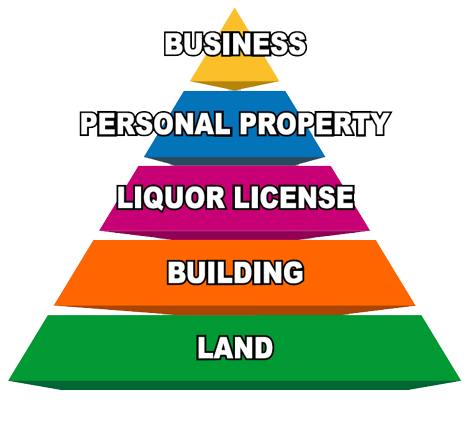The Need for a Top-Down Approach
Authentically solving for the value of each of the individual components requires the understanding that the value of each must be satisfied from the total cash-flow. And that total cash-flow effectively represents the aggregate of multiple income streams attributable to each component, or factor of production.
The factors of production represent a hierarchy

…before a positive business value is created, the business must satisfy the requirement for a return of and return on investment for the investment in land, the building improvements and the personal property.
The solution demands an approach more in line with the way that buyers and sellers view these properties in the marketplace – a top-down approach, coupled with traditional real estate appraisal techniques. This is in contrast to a bottom-up approach that would attempt to value each component and then to add those components together to derive the total value.
Such an approach would not be reflective of how buyers and sellers value these properties in the market place and would likely result in an unreliable value indication.An important concept in the separation or allocation of values within the total going concern is recognition that the factors of production represent a hierarchy. This hierarchy can be displayed as a pyramid and signifies that all cash-flows generated by the property first must go to satisfy the basic needs of the land, followed by the building improvements, before flowing to support the return of and return on investment of the personal property, and ultimately to the business enterprise value.
Cash flow to the business enterprise component can only begin after the cashflow requirements of the land, building improvements and personal property have been satisfied. Therefore, before a positive business value is created, the business must satisfy the requirement for a return of and return on investment for the investment in land, the building improvements and the personal property investment.
Therefore, intangible business value exists only to the extent that cash flows to the business exceed those required to support the tangible assets. As such, it is the riskiest component of value, and the first to decline or disappear when revenues decline. Which is one reason why appraising the business in isolation can sometimes lead to false results, in addition to the fact that appraising the real estate and business separately is often counter to the actions of the marketplace.
The “Excess Earnings Method”- A “New” Appraisal Tool
A tool to assist in overcoming the challenges faced by the traditional real estate appraisal techniques for these real estate-centered business enterprises emerged from a surprising source: an old business valuation technique that was developed by the US Treasury Department in 1920 to address the unique business valuation challenge posed at that time as a result of Prohibition. The valuation challenge at that time? To estimate lost intangible value suffered by breweries and distilleries as a result of the new legislation.
Fundamentally, this technique recognizes that each of the factors of production must be paid, and that each component can be valued by capitalizing the earnings that can be attributed to that asset. This technique was initially embraced by the business valuation community for many years, particularly for the appraisal of small businesses. However, its weakness for business valuations was the lack of empirical evidence to support many of the required assumptions. In contrast, with its application to real estate centered businesses, there is often adequate market data available to independently develop and reconcile the value conclusions using several metrics.
A 1997 Appraisal Journal article entitled “Defining and Allocating Going-Concern Value Components”, by T. Alvin Mobley III appears to have been the catalyst that brought this business valuation technique to the attention of the real estate appraisal industry. Since that time, the premise of this technique has played a prominent role in a number of textbooks to appraise a variety of special purpose properties, including golf courses, convenience stores and gas stations, and nursing facilities, as well as an influential article published in the Appraisal Journal’s Spring 2014 issue on “Restaurant Valuation”.
Thought leaders within the appraisal industry have largely accepted this approach as a “Best Practice” for the appraisal of special purpose properties like restaurants. In short, leading appraisers have come to recognize how the incorporation of this technique, often in conjunction with some of the traditional real estate appraisal approaches, is able to bridge that disconnect that had existed for so long.
